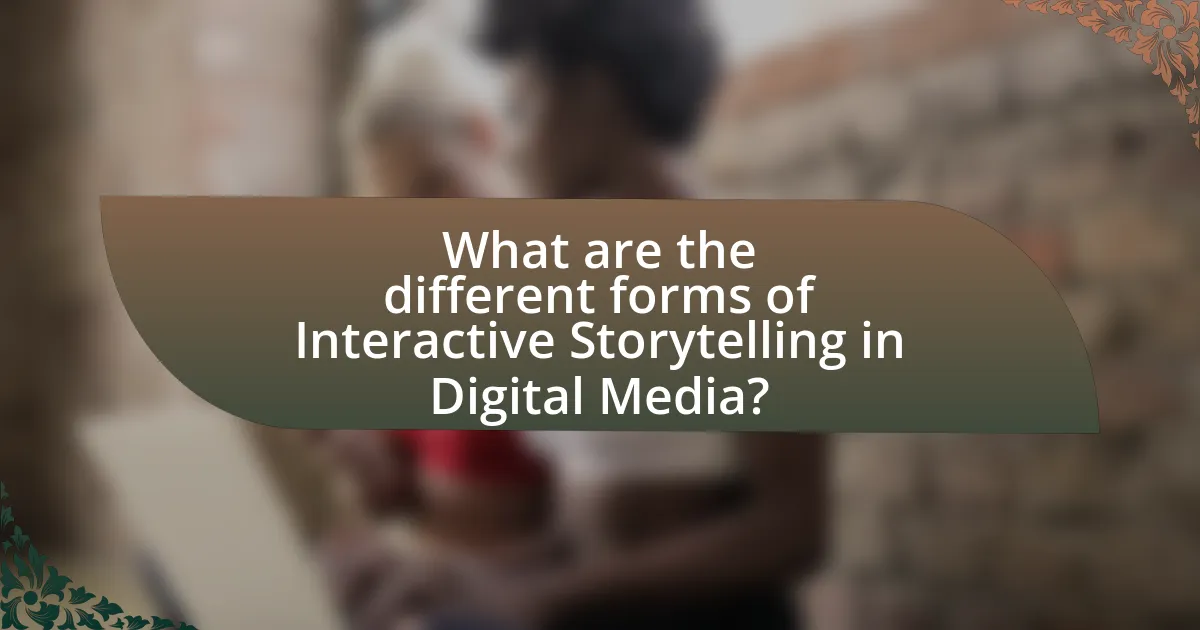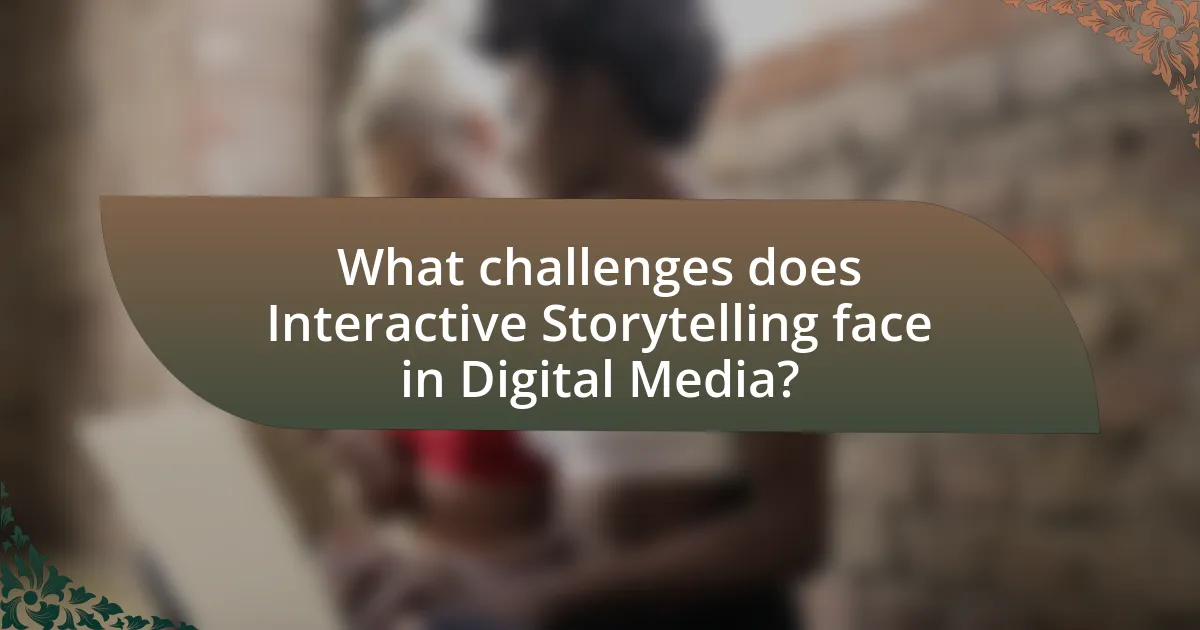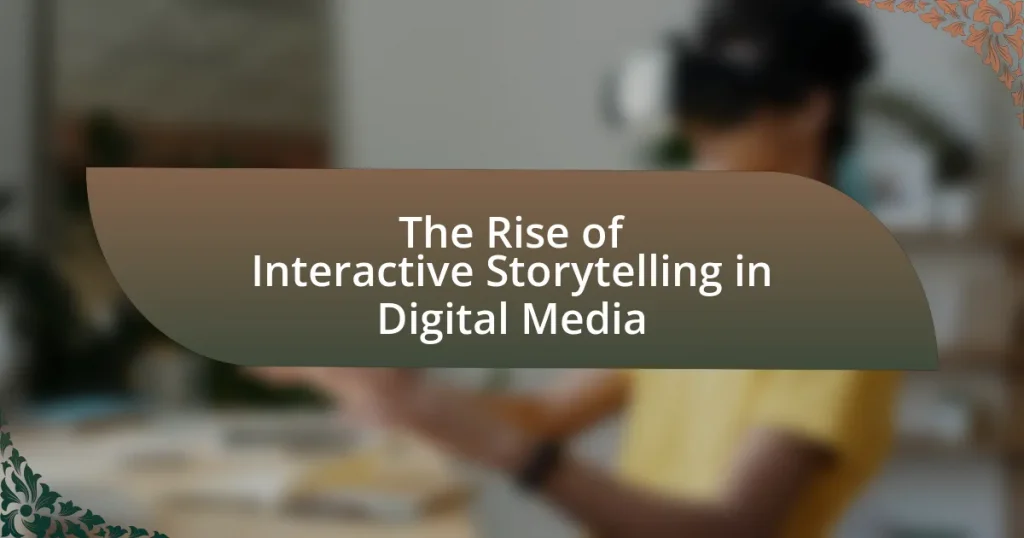Interactive storytelling in digital media is a narrative technique that empowers users to influence the direction and outcomes of a story through their choices and interactions. This article explores the differences between interactive and traditional storytelling, highlighting key elements such as user agency, narrative structure, and immersion. It examines the growing popularity of interactive storytelling, driven by technological advancements and changing audience preferences, while also addressing the challenges faced in maintaining narrative coherence and audience engagement. Various forms of interactive storytelling, including video games, interactive films, and social media campaigns, are discussed, along with best practices for creators to enhance user involvement and narrative depth.

What is Interactive Storytelling in Digital Media?
Interactive storytelling in digital media is a narrative approach that allows users to influence the story’s direction through their choices and interactions. This method engages audiences by providing them with agency, enabling them to shape the plot and outcomes based on their decisions. Research indicates that interactive storytelling enhances user engagement and emotional investment, as evidenced by platforms like video games and interactive films, which have seen significant growth in popularity and user participation.
How does Interactive Storytelling differ from traditional storytelling?
Interactive storytelling differs from traditional storytelling primarily in its emphasis on audience participation and choice. In traditional storytelling, the narrative is linear and predetermined, with the audience as passive recipients of the story. In contrast, interactive storytelling allows users to influence the direction and outcome of the narrative through their decisions, creating a dynamic experience. This interactivity is facilitated by digital platforms, which enable branching storylines and multiple endings, enhancing engagement and personalization. For example, video games and interactive films often incorporate player choices that directly affect character development and plot progression, showcasing the distinct nature of interactive storytelling compared to its traditional counterpart.
What are the key elements that define Interactive Storytelling?
Interactive storytelling is defined by key elements such as interactivity, narrative structure, user agency, and immersion. Interactivity allows users to influence the story’s direction through choices, creating a dynamic narrative experience. Narrative structure in interactive storytelling often includes branching paths, where different decisions lead to various outcomes, enhancing engagement. User agency empowers participants to make meaningful choices that affect the storyline, fostering a sense of ownership over the narrative. Immersion is achieved through rich multimedia elements, such as visuals, audio, and gameplay mechanics, which draw users into the story world. These elements collectively contribute to the unique nature of interactive storytelling, distinguishing it from traditional storytelling forms.
How does audience participation shape the narrative in Interactive Storytelling?
Audience participation significantly shapes the narrative in interactive storytelling by allowing individuals to influence plot developments and character decisions. This engagement transforms passive viewers into active participants, creating a personalized experience that reflects their choices and preferences. Research indicates that narratives in interactive formats, such as video games and interactive films, adapt dynamically based on user input, leading to multiple possible outcomes. For instance, a study by Murray (1997) in “Hamlet on the Holodeck” highlights how user agency can lead to unique story arcs, enhancing emotional investment and immersion. Thus, audience participation not only alters the direction of the narrative but also deepens the connection between the participant and the story.
Why has Interactive Storytelling gained popularity in recent years?
Interactive storytelling has gained popularity in recent years due to advancements in technology and the increasing demand for immersive experiences. The rise of high-speed internet, mobile devices, and interactive platforms has enabled creators to engage audiences in new ways, allowing for personalized narratives and user-driven choices. According to a report by the Interactive Advertising Bureau, 70% of consumers prefer interactive content over static content, highlighting the effectiveness of engagement strategies in digital media. This shift towards interactive formats has led to a surge in the production of video games, interactive films, and narrative-driven apps, catering to a growing audience that seeks deeper emotional connections and active participation in storytelling.
What technological advancements have contributed to the rise of Interactive Storytelling?
Technological advancements such as artificial intelligence, virtual reality, and interactive platforms have significantly contributed to the rise of interactive storytelling. Artificial intelligence enables personalized narratives by adapting storylines based on user choices, enhancing engagement and immersion. Virtual reality provides an immersive environment where users can experience stories in a three-dimensional space, allowing for deeper emotional connections. Additionally, interactive platforms like mobile apps and web-based games facilitate user participation, enabling audiences to influence plot outcomes actively. These advancements collectively transform traditional storytelling into dynamic, user-driven experiences, as evidenced by the growing popularity of interactive narratives in gaming and digital media.
How do changing audience preferences influence the growth of Interactive Storytelling?
Changing audience preferences significantly influence the growth of Interactive Storytelling by driving demand for more personalized and engaging content. As audiences increasingly seek immersive experiences that allow for agency and choice, creators are compelled to innovate and adapt their storytelling techniques. For instance, a survey by the Interactive Advertising Bureau in 2021 indicated that 70% of consumers prefer content that allows them to interact and influence the narrative, highlighting a clear shift towards interactive formats. This preference has led to the development of platforms and technologies that facilitate interactive storytelling, such as video games and interactive films, further propelling the genre’s expansion in digital media.

What are the different forms of Interactive Storytelling in Digital Media?
Interactive storytelling in digital media encompasses various forms, including video games, interactive films, virtual reality experiences, and transmedia narratives. Video games often allow players to make choices that influence the storyline, exemplified by titles like “The Witcher” series, where player decisions lead to different outcomes. Interactive films, such as “Bandersnatch,” enable viewers to select plot directions, creating a personalized viewing experience. Virtual reality experiences immerse users in a narrative environment, allowing them to interact with the story in real-time. Transmedia narratives extend storytelling across multiple platforms, engaging audiences through various media forms, such as books, films, and social media, as seen in franchises like “The Walking Dead.” These forms illustrate the diverse ways interactive storytelling engages audiences in digital media.
What types of media utilize Interactive Storytelling?
Interactive storytelling is utilized in various types of media, including video games, interactive films, virtual reality experiences, and web-based narratives. Video games, such as “The Walking Dead” series by Telltale Games, exemplify how player choices influence the storyline, creating a unique narrative experience. Interactive films, like “Black Mirror: Bandersnatch,” allow viewers to make decisions that affect the plot’s direction. Virtual reality experiences, such as “The Invisible Hours,” immerse users in a narrative where they can explore and interact with characters in real-time. Web-based narratives, including platforms like Twine, enable users to create and engage with branching storylines. These media forms leverage interactive storytelling to enhance user engagement and create personalized experiences.
How do video games implement Interactive Storytelling techniques?
Video games implement Interactive Storytelling techniques by allowing players to make choices that influence the narrative and character development. This is achieved through branching storylines, where decisions lead to different outcomes, and dialogue trees that enable players to engage with characters in meaningful ways. For example, games like “The Witcher 3: Wild Hunt” feature complex narratives that change based on player choices, demonstrating how player agency can shape the story. Additionally, mechanics such as moral dilemmas and character relationships further enhance the interactive experience, making players feel invested in the outcomes. This approach not only increases player engagement but also creates a unique storytelling experience tailored to individual play styles.
What role do interactive films and web series play in this genre?
Interactive films and web series serve as pivotal elements in the genre of interactive storytelling by enhancing viewer engagement through participatory narratives. These formats allow audiences to make choices that influence the storyline, creating a personalized viewing experience. For instance, Netflix’s “Black Mirror: Bandersnatch” exemplifies this role, as it offers multiple endings based on user decisions, thereby demonstrating the potential for interactive narratives to reshape traditional storytelling methods. This interactivity not only increases viewer investment but also encourages repeated viewings, as audiences explore different narrative paths.
How do social media platforms contribute to Interactive Storytelling?
Social media platforms enhance interactive storytelling by facilitating user engagement and participation in narrative development. These platforms allow users to contribute content, share experiences, and influence story outcomes through comments, polls, and collaborative features. For instance, platforms like Twitter and Instagram enable creators to post episodic content and receive immediate feedback, which can shape the direction of the story. Additionally, the use of hashtags and trends can create a communal storytelling experience, where audiences collectively engage with and expand upon the narrative. This interactivity not only enriches the storytelling process but also fosters a sense of community among participants, making the experience more immersive and dynamic.
What are some examples of successful Interactive Storytelling campaigns on social media?
Successful Interactive Storytelling campaigns on social media include the “The Walking Dead” by AMC, which utilized Facebook and Twitter to engage fans through character-driven narratives and choices that influenced the storyline. Another example is the “Taco Bell’s Live Más” campaign, where users participated in a choose-your-own-adventure style story on Instagram, allowing them to shape the narrative based on their preferences. Additionally, the “Coca-Cola’s Share a Coke” campaign invited consumers to share personalized stories by featuring their names on bottles, creating a personal connection and encouraging social sharing. These campaigns effectively leveraged user engagement and narrative interactivity to enhance brand loyalty and reach.
How do user-generated content and community engagement enhance Interactive Storytelling?
User-generated content and community engagement significantly enhance interactive storytelling by fostering a collaborative narrative experience that reflects diverse perspectives. This collaborative approach allows users to contribute their own stories, characters, and plotlines, which enrich the overall narrative and create a more immersive experience. For instance, platforms like Wattpad and interactive games such as “Minecraft” enable users to share their creations, leading to a dynamic storytelling environment where the audience becomes co-creators. Research indicates that 70% of users feel more connected to stories that incorporate their input, demonstrating the impact of community engagement on emotional investment and narrative depth.

What challenges does Interactive Storytelling face in Digital Media?
Interactive storytelling in digital media faces several challenges, including technological limitations, audience engagement, and narrative coherence. Technological limitations arise from the need for advanced platforms that can support complex interactions and high-quality graphics, which can be costly and require significant development time. Audience engagement is another challenge, as creators must find ways to captivate users who have diverse preferences and varying levels of interactivity, making it difficult to create universally appealing content. Additionally, maintaining narrative coherence becomes complex when multiple story paths are introduced, as creators must ensure that all potential outcomes are logical and satisfying to the audience. These challenges highlight the intricate balance required to successfully implement interactive storytelling in the evolving landscape of digital media.
What are the technical limitations of Interactive Storytelling?
Interactive storytelling faces several technical limitations, including constraints in narrative complexity, real-time processing capabilities, and user interface design. These limitations hinder the ability to create deeply immersive experiences that adapt seamlessly to user choices. For instance, narrative complexity is often restricted by the need for pre-defined story paths, which can limit the depth and variability of the storyline. Real-time processing capabilities are challenged by the need to manage multiple user inputs and outcomes simultaneously, which can lead to performance issues in more complex scenarios. Additionally, user interface design must balance accessibility with the richness of interaction, often resulting in compromises that can detract from the overall experience. These factors collectively restrict the potential of interactive storytelling to deliver fully engaging and personalized narratives.
How do budget constraints affect the production of Interactive Storytelling projects?
Budget constraints significantly limit the scope and quality of Interactive Storytelling projects. When financial resources are restricted, production teams often face challenges in hiring skilled personnel, acquiring advanced technology, and securing high-quality assets, which are essential for creating engaging narratives. For instance, a study by the Interactive Digital Media Institute found that projects with budgets under $100,000 often lack the depth and interactivity that larger-budget projects can afford, resulting in less immersive experiences for users. Consequently, budget limitations can lead to compromises in storytelling complexity, visual fidelity, and overall user engagement, ultimately affecting the project’s success in a competitive digital landscape.
What issues arise in maintaining narrative coherence in Interactive Storytelling?
Maintaining narrative coherence in interactive storytelling presents several issues, primarily due to the non-linear nature of user choices. The branching paths created by player decisions can lead to inconsistencies in character development, plot progression, and thematic elements. For instance, if a player chooses to save a character in one scenario but later encounters a narrative where that character is absent, it disrupts the continuity of the story. Additionally, the challenge of integrating diverse player choices while ensuring a cohesive narrative arc can result in fragmented storytelling, where the overall message or theme becomes diluted. Research by Murray (1997) in “Hamlet on the Holodeck” highlights that the complexity of interactive narratives often leads to a loss of traditional storytelling techniques, making it difficult to maintain a unified narrative experience.
How does audience engagement impact the success of Interactive Storytelling?
Audience engagement significantly enhances the success of interactive storytelling by fostering a deeper emotional connection and investment in the narrative. When audiences actively participate in shaping the story, their involvement increases satisfaction and retention, leading to a more memorable experience. Research indicates that interactive narratives, such as those found in video games and immersive media, can boost engagement levels by up to 50% compared to traditional storytelling formats. This heightened engagement not only encourages repeat interactions but also amplifies word-of-mouth promotion, further contributing to the success of the storytelling experience.
What strategies can creators use to enhance audience involvement in the story?
Creators can enhance audience involvement in the story by incorporating interactive elements such as choices, feedback mechanisms, and immersive experiences. By allowing audiences to make decisions that influence the narrative direction, creators foster a sense of agency and investment in the story. Research indicates that interactive storytelling can increase emotional engagement; for instance, a study published in the Journal of Interactive Media found that participants who made choices in a narrative reported higher levels of enjoyment and connection to the characters. Additionally, utilizing multimedia elements like visuals, sound, and gamification can further captivate audiences, making the storytelling experience more dynamic and participatory.
How can feedback loops be effectively integrated into Interactive Storytelling?
Feedback loops can be effectively integrated into interactive storytelling by allowing user choices to influence narrative outcomes and character development in real-time. This integration enhances user engagement and creates a personalized experience, as seen in games like “The Walking Dead,” where player decisions directly affect story progression and character relationships. Research indicates that feedback loops in interactive narratives can lead to increased emotional investment and satisfaction, as players feel their choices have meaningful consequences.
What are best practices for creating effective Interactive Storytelling experiences?
Best practices for creating effective Interactive Storytelling experiences include designing engaging narratives, allowing user agency, and integrating multimedia elements. Engaging narratives captivate users by providing relatable characters and compelling plots, which enhance emotional investment. Allowing user agency empowers participants to make choices that influence the story’s direction, fostering a sense of ownership and immersion. Integrating multimedia elements, such as visuals, audio, and interactive features, enriches the storytelling experience and caters to diverse learning styles. Research indicates that interactive narratives can increase user engagement by up to 50%, demonstrating the effectiveness of these practices in enhancing user experience.
How can creators balance interactivity and narrative depth in their projects?
Creators can balance interactivity and narrative depth by integrating branching storylines that allow player choices to influence the plot while maintaining a cohesive narrative structure. This approach enables users to engage actively with the story, enhancing their emotional investment, as seen in successful interactive media like “The Walking Dead” game series, where player decisions significantly impact character development and story outcomes. By employing techniques such as character arcs that adapt based on user choices, creators can ensure that interactivity enriches rather than detracts from narrative depth, leading to a more immersive experience.
What tools and platforms are recommended for developing Interactive Storytelling content?
Recommended tools and platforms for developing Interactive Storytelling content include Twine, Unity, and Inklewriter. Twine is an open-source tool that allows creators to design nonlinear stories through a visual interface, making it accessible for beginners. Unity is a powerful game development platform that supports interactive narratives with advanced graphics and scripting capabilities, widely used in the gaming industry. Inklewriter is specifically designed for writing interactive fiction, enabling authors to create branching narratives easily. These tools are validated by their widespread use in the industry, with Twine being utilized in educational settings and Unity powering numerous successful interactive games.



